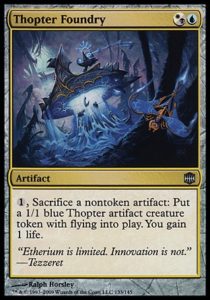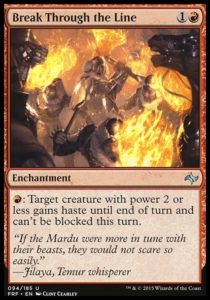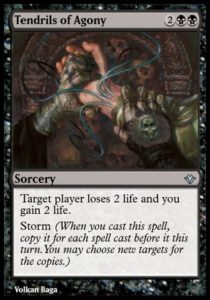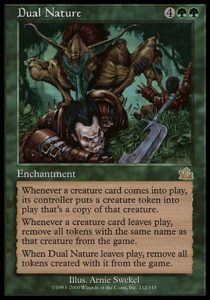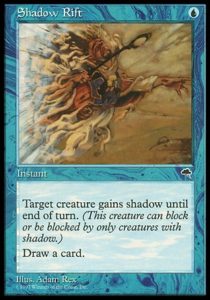When last we met, combo (specifically combos and combo decks in cube) was under the microscope. Combo and combo deck were defined, but I had trouble distinguishing combo from mere synergistic interactions ([casthaven]Splinter Twin[/casthaven] + [casthaven]Deceiver Exarch[/casthaven] is an obvious combo, [casthaven]Vent Sentinel[/casthaven] + [casthaven]Vent Sentinel[/casthaven] is not really a combo [according to our definition], and [casthaven]Stoneforge Mystic[/casthaven] + [casthaven]Batterskull[/casthaven] maybe counts as a combo). Furthermore, we didn’t really talk much about combo decks, nor did I get into why I think combo decks are unnecessary in cube. We’ve got a lot of ground to cover, so once more, let’s dive right in!
Where Combo stops and Synergy Begins
Is [casthaven]Stoneforge Mystic[/casthaven] + [casthaven]Batterskull[/casthaven] a combo? Well, according to our definition (“A combo is a combination of two or more cards that have a powerful, often game-winning effect.”)… it’s unclear. Tutoring and cheating [casthaven]Batterskull[/casthaven] into play is strong, but it’s very ‘fair’—you’re playing a (discounted) creature and winning the game by attacking with it over several turns.
Compare this to [casthaven]Reanimate[/casthaven] + [casthaven]Entomb[/casthaven] + [casthaven]Griselbrand[/casthaven]. You’re getting a much more substantial discount, a stronger creature, and a stronger effect. Still, you’re essentially doing the same thing as [casthaven]Stoneforge Mystic[/casthaven] + [casthaven]Batterskull[/casthaven]: winning the game ‘fairly’ by attacking with a discounted creature.
Frankly, I don’t think that the problem with [casthaven]Stoneforge Mystic[/casthaven] + [casthaven]Batterskull[/casthaven] is that it wins ‘fairly.’ Even [casthaven]Splinter Twin[/casthaven] kills ‘fairly’ by attacking (though the kill involves creating infinite creatures, which is hardly fair Magic). I think that the problem is its effect simply isn’t dramatic enough; [casthaven]Batterskull[/casthaven] is a nuisance that can take over the game, whereas [casthaven]Griselbrand[/casthaven] needs to be answered immediately or the game ends (and [casthaven]Splinter Twin[/casthaven] generally will end the game immediately if unanswered).
Our working definition of combo, that it has a “powerful, often game-winning effect,” is ambiguous and has wiggle room. There’s no clear line in the sand between [casthaven]Splinter Twin[/casthaven], [casthaven]Reanimate[/casthaven], [casthaven]Stoneforge Mystic[/casthaven], and [casthaven]Vent Sentinel[/casthaven][casthaven][/casthaven]. We probably cross this line somewhere near [casthaven]Stoneforge Mystic[/casthaven] and have definitely shot past it when we hit [casthaven]Vent Sentinel[/casthaven]. So what?
Why is this significant? I believe that there’s some ambiguity in what constitutes a proper ‘combo’ in cube. People are looking for a very specific, substantially powerful class of effect (though where the precise line between combo and ~combo lies is unclear). They want massively discounted (otherwise night-uncastable) effects, infinite something (creatures, mana, mill, etc.), or something that just says, “you win.” I don’t believe that such powerful effects should exist in lowered powered cubes (and that lower-powered synergies get promoted to combo status in such cubes), but I’ll table that argument for another time. In other news, none of our aforementioned descriptions of combo aptly describe the most common and obvious combo deck: storm.
Combo decks, not decks with combos
Storm is not merely one of the most common combo decks in cube, it’s generally the combo deck. It plays Magic along a completely different axis and wins not by assembling a combo of 2-4 cards, but by playing 8+ spells in a turn, few of which are individually integral to the actual kill. It also plays quite differently than our previous exemplar of combo: [casthaven]Splinter Twin[/casthaven]. Splinter Twin digs through its deck to combine two specific cards, whereas Storm is trying to obtain a critical mass of lots of cards (none of which are individually essential). Storm highlights the two kinds of combo decks allowed by our definition:
A combo deck is designed to win by assembling a combo (sometimes with a non-combo Plan B). It plays along an unusual axis/doesn’t play ‘normal’ Magic. Oftentimes, but not always, these decks play few to no creatures and have no Plan B. These decks are often, but not always, difficult to interact with (particularly without counterspells, hand disruption, or dedicated hate cards).
Storm is not really assembling a combo, though it is a combo deck that otherwise fits our definition perfectly: it plays along an unusual axis, has few to no creatures, and tends to have no Plan B. Interestingly, Storm is quite unlike our exemplar combo pieces, like [casthaven]Splinter Twin[/casthaven], [casthaven]Time Vault[/casthaven], and [casthaven]Channel[/casthaven]; none of our combos are really part of dedicated cube combo decks. Combos are irreplaceable one-ofs that need to be found and assembled (or nearly irreplaceable—[casthaven]Kiki-Jiki, Mirror Breaker[/casthaven] is the only substitute for [casthaven]Splinter Twin[/casthaven]), whereas Storm is composed of many (often redundant) pieces and a functional storm deck is chiefly composed of storm enablers.
This distinction is important, because when people are talking about combo in cube, they’re actually talking about two different things: combo decks, archetypes which requires lots of support (and which tend not to rely on a specific combo to win), and combos, game-winning (or otherwise exceptionally strong) combinations of a small set of specific cards (which can fit into almost anything of the appropriate color but are best in a deck with lots of card draw or tutors). If your cube is going to support Storm, Reanimator, or Tinker decks, you’re going to need to include enough cards for drafters to achieve critical mass. However, if you want to support a combo, you just need to include the cards that comprise the combo. That’s a substantial difference in required support.
My final word on combo decks is that they’re not the only decks that require critical mass. Ramp is a critical mass archetype that’s about producing as much mana as fast as possible and then playing a very expensive spell early (it just looks fairer because it’s playing more ‘normal’ Magic). It doesn’t matter whether this is being accomplished with [casthaven]Llanowar Elves[/casthaven], [casthaven]Farseek[/casthaven], or [casthaven]Joraga Treespeaker[/casthaven], nor does it matter whether you’re ramping into [casthaven]Tooth and Nail[/casthaven], [casthaven]Genesis Wave[/casthaven], or [casthaven]Kozilek, Butcher of Truth[/casthaven]. Hell, monored aggro is a critical mass archetype: you need a ton of cheap creatures, particularly one-drops, and probably a finisher like [casthaven]Sulfuric Vortex[/casthaven], [casthaven]Fireblast[/casthaven], or [casthaven]Hellrider[/casthaven], though you don’t need any specific card to fill either role.
While Storm plays in a very unique way, it’s hardly unique in being a critical mass deck.
Why is Combo Necessary?
I’ll end on something less technical. I don’t believe that game-winning combos or combo decks are necessary for a healthy Limited format. My reason is simple: very, very few Limited environments have real combo decks and even fewer have game-ending combos. Yes, there’s plenty of synergy, and there are excellent critical mass combo decks like [casthaven]Furnace Celebration[/casthaven], [casthaven]Burning Vengeance[/casthaven], and [casthaven]Trail of Mystery[/casthaven]; however, combo isn’t necessary for all Limited formats to be balanced. Sure, it’s cool to have, but it’s not something that all cubes need.
Secondly, critical mass combo decks are parasitic. They require a lot of support, however, these support cards tend to range from bad to unplayable in almost every other deck. If you include too many parasitic archetypes, then you essentially stop drafting once you settle on an archetype (since you’re presumably not competing with most, if any players for your deck). Even if you only have one combo deck, if it’s sufficiently parasitic, as Storm tends to be, then you’re diluting your cube with cards that only one drafter can make use of. I prefer more flexible drafting, where every card could see play in at least two kinds of deck, or at least a different color combination of that archetype. But that’s just me.
—Zachary Barash
Zachary Barash has been playing Magic on and off since 1994. He loves Limited and drafts every available format (including several that aren’t entirely meant to be drafted). He’s a proud Cube owner and improviser with an obsession with Indian food that borders on being unhealthy.

